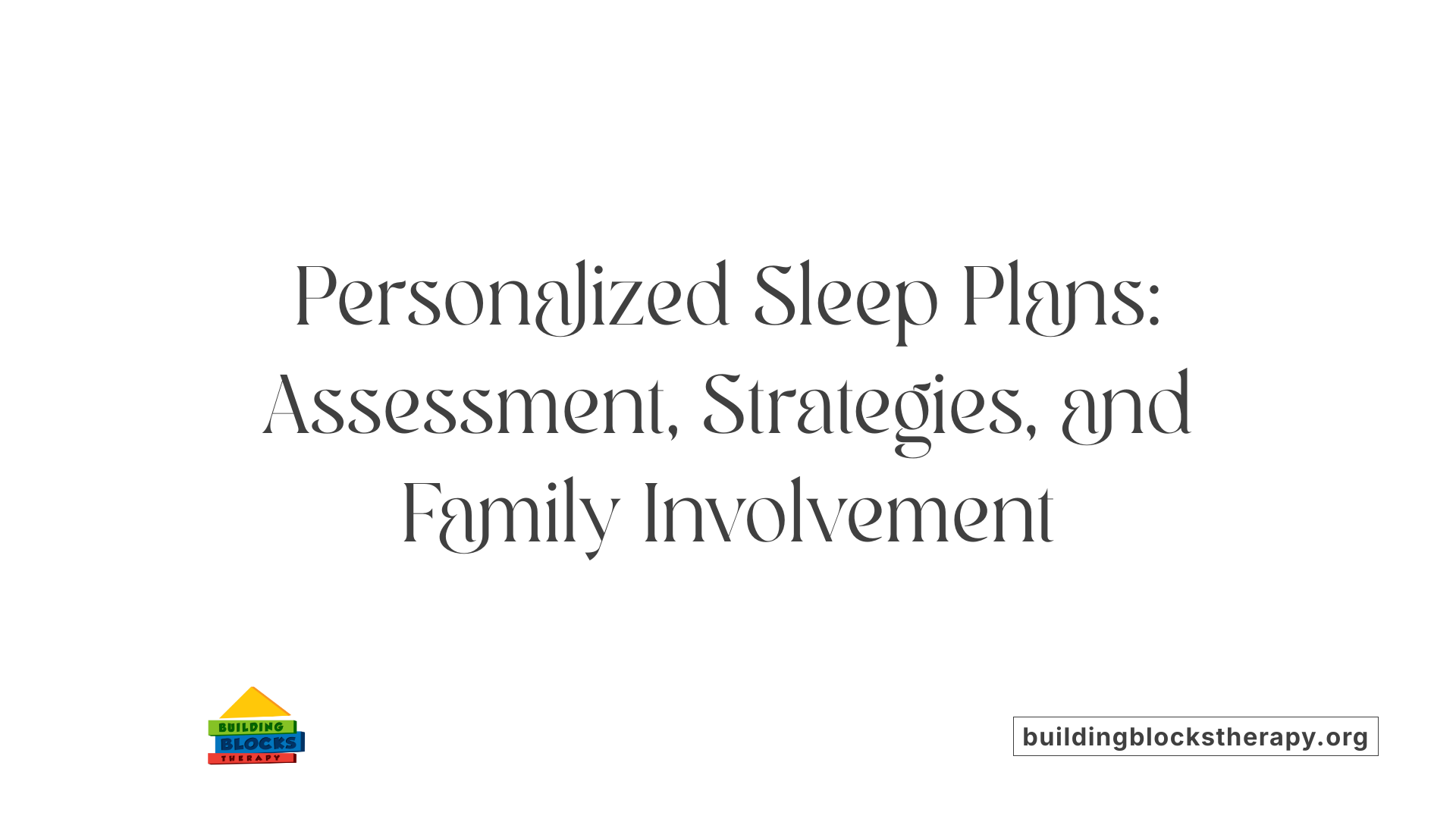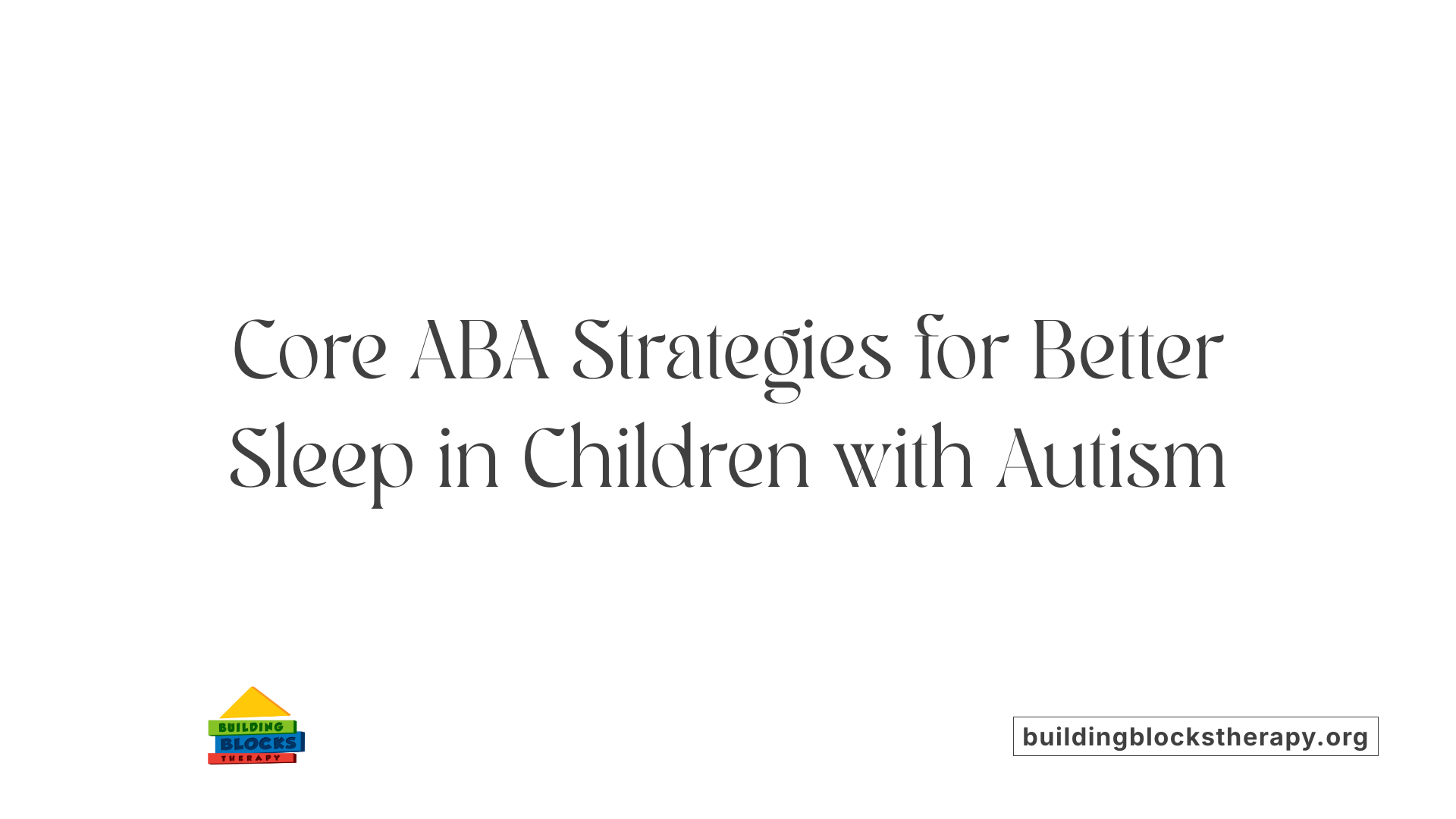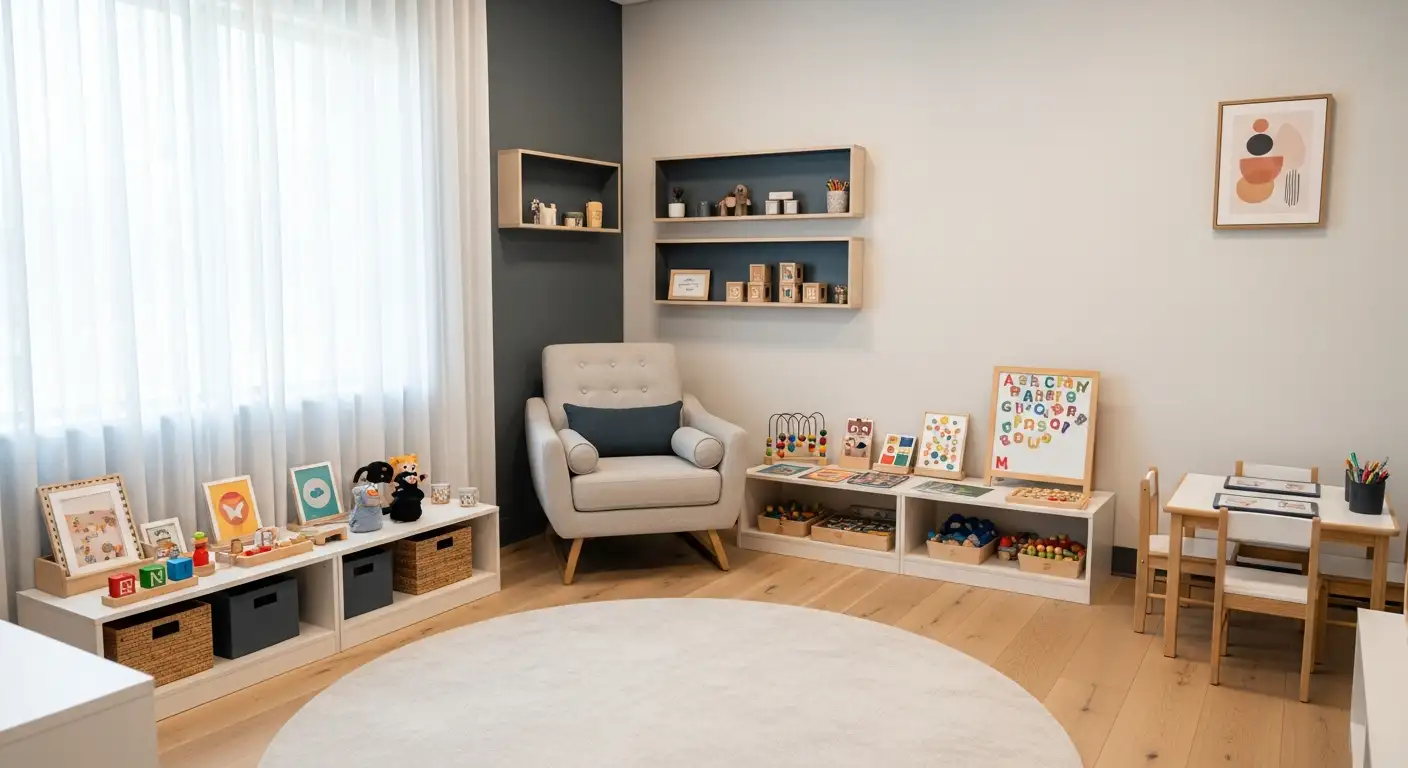ABA Therapy for Sleep Problems
Transforming Bedtimes: How ABA Therapy Enhances Sleep for Children with Autism

Understanding the Critical Role of ABA in Managing Sleep Issues in Children with Autism
Sleep disturbances are a common challenge faced by children with autism spectrum disorder (ASD), affecting up to 80% of this population. These sleep issues—ranging from difficulty falling asleep to frequent night wakings—can exacerbate core autism symptoms, increase daytime behavioral problems, and impact family well-being. Applied Behavior Analysis (ABA) therapy offers a research-backed, systematic approach to address these challenges, focusing on establishing healthy sleep habits through behavioral interventions customized to each child's unique needs.
Prevalence and Impact of Sleep Problems in Children with Autism
 Children with autism spectrum disorder (ASD) often face significant sleep challenges, with reports indicating that up to 80% of this population experience sleep disturbances. Common issues include difficulty falling asleep (prolonged sleep onset latency), frequent awakenings during the night, early morning wake-ups, and a reduction in overall sleep duration.
Children with autism spectrum disorder (ASD) often face significant sleep challenges, with reports indicating that up to 80% of this population experience sleep disturbances. Common issues include difficulty falling asleep (prolonged sleep onset latency), frequent awakenings during the night, early morning wake-ups, and a reduction in overall sleep duration.
These sleep difficulties are more than mere inconveniences—they can exacerbate core autism symptoms. For example, poor sleep quality has been linked to decreased social communication skills and an increase in restricted, repetitive behaviors. Additionally, inadequate or disrupted sleep can lead to heightened daytime behavioral problems such as aggression, irritability, and self-injurious behaviors.
The effects are reciprocal; worsened sleep can intensify autism-related challenges, creating a cycle that affects the child's overall wellbeing and development. To address these issues effectively, behavioral approaches—primarily based on Applied Behavior Analysis (ABA)—are employed as first-line interventions. These strategies involve establishing consistent bedtime routines, improving sleep hygiene, and using reinforcement techniques like visual schedules and sleep tools such as bedtime passes.
Before initiating behavioral treatment, it is essential to rule out medical causes of sleep disturbances—such as sleep apnea or gastrointestinal issues—via consultation with a pediatrician. Once medical concerns are excluded, ABA-based strategies can be tailored to each child's specific triggers and needs, often involving parent training and home-based therapy. This structured, evidence-backed approach aims to establish sustainable sleep routines, leading to improvements in sleep quality, which subsequently benefits daytime behavior and overall family functioning.
Understanding Sleep Patterns and Disturbances in Children with Autism

Elevated rates of sleep problems in children with ASD
Children diagnosed with autism spectrum disorder (ASD) often experience significant sleep challenges. Research indicates that up to 80% of children with autism face sleep disturbances, far exceeding the rates seen in typically developing children. These sleep issues include difficulties at bedtime and throughout the night, which can interfere with daily functioning and overall well-being.
Types of sleep disturbances—prolonged sleep latency, night wakings, early awakening, short sleep duration
Children with autism commonly encounter various sleep problems. These include:
- Prolonged sleep latency: Taking an unusually long time to fall asleep after going to bed.
- Frequent night awakenings: Waking up multiple times during the night.
- Early morning awakenings: Rising too early and having trouble returning to sleep.
- Short total sleep duration: Overall less sleep than recommended for their age.
These disturbances can lead to increased daytime irritability, difficulties in learning, and worsening of core autism symptoms like social communication deficits and repetitive behaviors.
How behavior therapy can support better sleep
Behavioral approaches offer effective strategies to tackle sleep issues. Interventions such as establishing consistent bedtime routines, creating visual schedules, and removing foods with caffeine close to bedtime can promote better sleep patterns. Techniques like graduated extinction, where parents gradually increase the time before responding to a child's night-time cries, teach children to self-soothe and stay asleep longer.
Home-based ABA therapy plays a vital role by developing personalized sleep plans that include environmental modifications and reinforcement tactics. Therapists work closely with parents, coaching them on implementing routines and understanding triggers like anxiety or environmental disruptions.
Progress is monitored through sleep diaries and parent reports, allowing adjustments to strategies as needed. Such approaches, when implemented consistently, have been shown to improve sleep duration and quality, which subsequently supports improved daytime behavior and overall family well-being.
In sum, understanding the specific sleep challenges in children with ASD and employing targeted behavioral interventions can lead to meaningful improvements. Working alongside medical professionals and using structured, individualized plans ensures a comprehensive approach to overcoming sleep disturbances.
Assessment and Personalization of Sleep Interventions

Why is it important to rule out medical causes before starting behavioral sleep interventions?
Before implementing behavioral strategies to improve sleep in children with autism, it is crucial to consult with a pediatrician to rule out medical conditions that could be causing sleep problems. Conditions like sleep apnea, gastrointestinal issues, or medication side effects may require medical treatment. Addressing these concerns first ensures that interventions target the behavioral aspects of sleep difficulties without overlooking underlying medical issues.
How are sleep problems assessed in children with autism?
Assessment tools such as sleep logs, validated questionnaires (e.g., Children's Sleep Habits Questionnaire and the Family Inventory of Sleep Habits), and objective measures like actigraphy are used to understand the extent and nature of sleep disturbances. Sleep diaries maintained by parents help track bedtime routines, sleep onset, night wakings, and morning wake times. These assessments identify patterns and environmental factors that may impact sleep, guiding tailored intervention plans.
How are individualized sleep plans developed?
Based on thorough assessments, clinicians develop personalized sleep interventions that address specific challenges faced by each child. This may include establishing consistent bedtime routines, environmental modifications like reducing sensory overstimulation, and visual supports such as schedules and social stories. The goal is to create sustainable routines that promote self-soothing and improve sleep duration and quality.
What treatment options and techniques does ABA therapy use to manage sleep difficulties in children with autism?
ABA therapy utilizes diverse, evidence-based methods tailored to the child's unique needs. These include:
- Establishing consistent bedtime routines with visual schedules
- Using positive reinforcement to promote desired sleep behaviors
- Modifying the sleep environment to minimize sensory overload
- Employing behavioral strategies such as:
- Gradual extinction: withholding attention during sleep resistance behaviors to encourage back-to-sleep
- Fading parental presence: slowly decreasing physical comfort and support at bedtime
- Sleep restriction: limiting time in bed to consolidate sleep
- Fading bedtime: adjusting bedtime based on actual sleep onset times
- Scheduled awakenings: waking the child before typical night wakings to promote continuous sleep
- Bedtime passes: providing a controlled means for the child to leave the room briefly
- Using visual supports like social stories to reduce bedtime anxiety
Collaboration with occupational therapists and sleep specialists ensures interventions are customized to address sensory sensitivities, anxiety, and other individual factors. Parental training and coaching are vital components, empowering families to implement strategies consistently and effectively.
How does home-based ABA therapy contribute to improving sleep in children with autism?
Home-based ABA offers several advantages, including a familiar, comfortable environment and ongoing real-time support from therapists. This setting allows for personalized, adaptable strategies, family involvement, and direct coaching, leading to more effective implementation. Regular monitoring through sleep diaries and parent reports helps adjust interventions, leading to better sleep outcomes. Consistent routines, environmental tweaks, and behavioral reinforcement foster lasting improvements in sleep quality and reduce nighttime resistance, positively impacting daytime behavior and overall family well-being.
| Technique | Description | Aim | Benefits |
|---|---|---|---|
| Bedtime routine | Structured activities before bed | Reduce anxiety, promote relaxation | Better sleep onset and duration |
| Visual supports | Schedules, social stories | Clarify expectations, reduce resistance | Improved compliance and reduced fussiness |
| Gradual extinction | Controlled ignoring of resistance behaviors | Increase self-soothing | Shorter sleep resistance episodes |
| Fading parental presence | Gradually reducing physical support | Foster independence | Longer sleep periods |
| Sleep environment modification | Sensory adjustments | Minimize overstimulation | Quieter, more comfortable sleep space |
| Parental training | Teaching strategies to parents | Maintain consistency | Long-term sleep improvements |
These approaches, grounded in research and personalized to each child's needs, are essential in creating sustainable, healthy sleep habits, ultimately leading to improved daytime functioning and family harmony.
Core ABA Strategies for Enhancing Sleep in Children with Autism

How does ABA therapy address sleep problems in children with autism?
ABA therapy approaches sleep challenges by implementing behavioral techniques designed to promote healthy sleep habits. This involves establishing consistent bedtime routines that include visual supports and calming activities, creating an environment conducive to sleep, and teaching children self-soothing skills.
Behavioral strategies such as graduated extinction, bedtime fading, stimulus control, and the use of visual schedules are tailored to each child's needs based on thorough assessments. These techniques help reduce sleep onset latency, decrease night wakings, and lengthen total sleep duration.
Parental involvement plays a pivotal role. Therapists train parents in implementing routines and responding effectively to night awakenings, which fosters consistency and independence in sleep behaviors. Regular monitoring through sleep diaries and parent reports allows for ongoing adjustments to the intervention plan.
Research supports that these ABA-based interventions not only improve sleep but also positively influence daytime behaviors and family well-being. The systematic, personalized nature of ABA makes it a robust approach for addressing sleep problems in children with autism, contributing to their overall development and quality of life.
Behavioral Techniques for Sleep Improvement in ABA Therapy

What behavioral strategies are used within ABA therapy to improve sleep in children with autism?
ABA (Applied Behavior Analysis) therapy employs various behavioral techniques aimed at improving sleep patterns among children with autism. These strategies focus on modifying behaviors, establishing routines, and creating conducive sleep environments.
A fundamental approach involves establishing consistent and predictable bedtime routines. These routines often include visual schedules and calming activities that help children relax and signal that it's time to sleep. Visual schedules are especially helpful for children with ASD, providing clear expectations and reducing anxiety associated with bedtime.
Another effective method is bedtime fading, where the child's bedtime is gradually adjusted to better match their natural sleep onset times. This approach helps in promoting earlier sleep onset and better sleep quality.
Specific ABA techniques like graduated extinction and escape extinction are frequently used. Graduated extinction involves gradually increasing the amount of time parents wait before responding to a child's cries or tantrums, encouraging the child to develop self-soothing skills and sleep independently. Escape extinction, on the other hand, prevents or removes access to reinforcement when a child exhibits behaviors like crying or trying to leave the bed, which helps reduce sleep resistance.
Scheduled awakenings are also implemented to prevent early night wakings. This involves waking the child briefly before their typical night awakenings to teach them to stay asleep throughout the night.
To motivate positive sleep behaviors, reinforcement systems such as reward charts or a bedtime pass—allowing a child to leave the room briefly for a specific purpose—are used. These tools serve to reduce disruptive behaviors, like calling out or leaving the room during sleep.
Parental involvement is crucial, with therapists providing coaching and training on how to implement these strategies consistently. Continuous monitoring and adjustments based on the child's progress are essential for long-term success.
Overall, ABA therapy tailors these techniques to meet each child's unique needs, fostering sustainable sleep habits that contribute to better daytime functioning and family well-being.
The Role of Parental Involvement and Training in Sleep Interventions

How does ABA therapy address sleep problems in children with autism?
ABA therapy leverages behavioral techniques specifically tailored to each child's sleep issues. It involves establishing consistent bedtime routines, using positive reinforcement, and teaching children self-soothing skills. Therapists conduct detailed assessments to identify triggers that disrupt sleep, such as anxiety or environmental factors, then develop personalized strategies. These may include graduated extinction—gradually increasing wait times before responding to a child's crying—or bedtime fading, where the child's bedtime is adjusted gradually.
Crucially, parental involvement forms the backbone of effective intervention. Parents are trained to implement routines, respond to night wakings appropriately, and reinforce positive sleep behaviors, which makes changes sustainable at home.
Research shows that behavioral strategies supported by ABA can significantly shorten sleep onset latency, reduce night wakings, and boost overall sleep duration. Improvements not only help with sleep but also positively influence daytime behaviors, reducing problem behaviors such as aggression or hyperactivity, and enhancing daily functioning.
Continuous monitoring through sleep logs and parent reports allows for ongoing adjustments, ensuring that interventions remain effective and tailored to evolving needs. This collaborative approach enhances the consistency and success of sleep interventions for children with autism.
Monitoring Progress and Ensuring Sustainability of Sleep Habits
How do sleep diaries, parent reports, and ongoing assessment help in managing sleep issues?
Tracking sleep progress is essential in identifying what strategies work best for each child. Sleep diaries provide a detailed record of sleep patterns, including sleep onset, awakenings, and wake times. Parents can note environmental factors, behaviors, and routines that influence sleep quality. Regular reporting from parents offers valuable insights into ongoing changes and consistencies.
Healthcare providers and therapists often use these tools alongside standardized assessments like the Children's Sleep Habits Questionnaire (CSHQ) and actigraphy data. Ongoing assessment helps determine if sleep difficulties are resolving or worsening.
This continuous monitoring allows clinicians to tailor interventions, make necessary adjustments, and ensure the sustainability of positive sleep habits over time.
What treatment options and techniques does ABA therapy use to manage sleep difficulties in children with autism?
ABA therapy employs various evidence-based techniques to improve sleep in children with autism. Establishing consistent bedtime routines and structured schedules helps create predictability, reducing anxiety around bedtime.
Behavioral strategies such as graduated extinction involve gradually increasing the response time before providing attention to a child who is upset or resisting sleep. Fading parental presence, or gradually reducing parental intervention, encourages independent sleep skills.
Environmental modifications, like reducing sensory overstimulation in the bedroom, support better sleep onset and maintenance.
Visual supports, including social stories and visual schedules, help children understand what to expect at bedtime, alleviating fear and resistance.
Furthermore, collaboration with specialists ensures interventions are individualized, considering sensory sensitivities and anxiety triggers. These strategies are reinforced through parent training, making sleep improvements sustainable.
How does ongoing assessment support the continuation of effective sleep habits?
Regular assessment through sleep diaries, parent reports, and behavioral observations offers an effective way to evaluate the success of interventions. It helps identify areas needing adjustment and confirms progress.
When children show improved sleep patterns, maintenance strategies can be reinforced. If challenges persist, clinicians can revisit specific interventions, introduce new techniques, or adjust environmental factors to enhance outcomes.
This systematic approach ensures that sleep habits established during therapy are embedded into daily routines, promoting long-term benefits. Ultimately, ongoing assessment supports the child's transition to independent, consistent sleep patterns, contributing to overall well-being.
| Tools Used | Function | Additional Details |
|---|---|---|
| Sleep Diaries | Track sleep patterns and behaviors | Daily logs maintained by parents to identify triggers and progress |
| Parent Reports | Provide subjective insights | Weekly or monthly updates on sleep and behavior changes |
| Standardized Questionnaires | Assess sleep habits systematically | CSHQ, FISH, etc., for comprehensive evaluation |
| Actigraphy | Objectively measure sleep and activity | Wearable devices providing data on sleep duration and quality |
| Behavioral Observations | Assess responses to interventions | Conducted by therapists during sessions or home visits |
Using a combination of these tools aids in creating a detailed picture of sleep progress, ensuring interventions are adapted as needed for sustained success.
Long-Term Benefits and Family Well-Being
Improving sleep in children with autism through Applied Behavior Analysis (ABA) research-backed approaches can lead to profound and lasting benefits for both the child and their family.
Enhanced sleep quality usually results in better daytime behavior. Children who sleep more soundly tend to show improvements in social interactions, communication skills, and reduce problematic behaviors like aggression or self-injury. These behavioral improvements can promote a more positive and cooperative attitude during daily routines.
For families, stable sleep patterns help establish a predictable and smooth daily rhythm. Routine consistency not only benefits the child's well-being but also reduces parental stress. When children with autism sleep better, parents often experience decreased fatigue and frustration, contributing to increased patience and emotional stability.
Overall family well-being is significantly boosted when sleep issues are addressed effectively. More restful nights enable parents to engage more actively in their child's development and other family activities. With fewer night wakings and disturbances, family relationships tend to strengthen, creating a supportive environment that fosters growth and resilience.
ABA therapy’s focus on creating sustainable, personalized sleep routines supports long-term adherence. Because routines are tailored to individual needs and reinforced through positive strategies like visual schedules and environmental adjustments, these improvements are more likely to be maintained over time. As a result, children develop healthier sleep habits that continue well into adolescence.
In summary, targeted ABA sleep interventions not only improve immediate sleep outcomes but also produce lasting positive impacts, fostering better daytime behavior, enriching family routines, and enhancing overall family quality of life.
| Aspect | Benefits | Details |
|---|---|---|
| Sleep Quality | Better rest, fewer night wakings | Improvements in sleep onset, duration, and continuity |
| Child Behavior | Reduced problem behaviors | Increased social skills and decreased aggression |
| Family Routine | Stability and predictability | Consistent schedules and reduced parental stress |
| Overall Well-Being | Long-term positive effects | Sustained habits and improved family dynamics |
Empowering Families with Effective Sleep Strategies
ABA therapy offers a comprehensive, individualized approach to managing sleep problems in children with autism, emphasizing behavioral techniques, parental involvement, and ongoing assessment. By addressing sleep disturbances through structured routines, environmental modifications, and reinforcement strategies, ABA not only improves sleep quality but also enhances overall child functioning and family harmony. Collaborating with professionals and implementing evidence-based interventions can lead to sustainable improvements, empowering families to foster healthier sleep habits and better quality of life for children with autism.
References
- Regulating Sleep - Association for Science in Autism Treatment
- Recommendations for Identifying Sleep Problems and Treatment ...
- Home-Based ABA Therapy for Better Sleep for Children with Autism
- Ways ABA Therapy Can Assist With Sleep Issues
- Regulating Sleep - Association for Science in Autism Treatment
- Recommendations for Identifying Sleep Problems and Treatment ...
- Treating Sleep Disorders - Autism Research Institute






